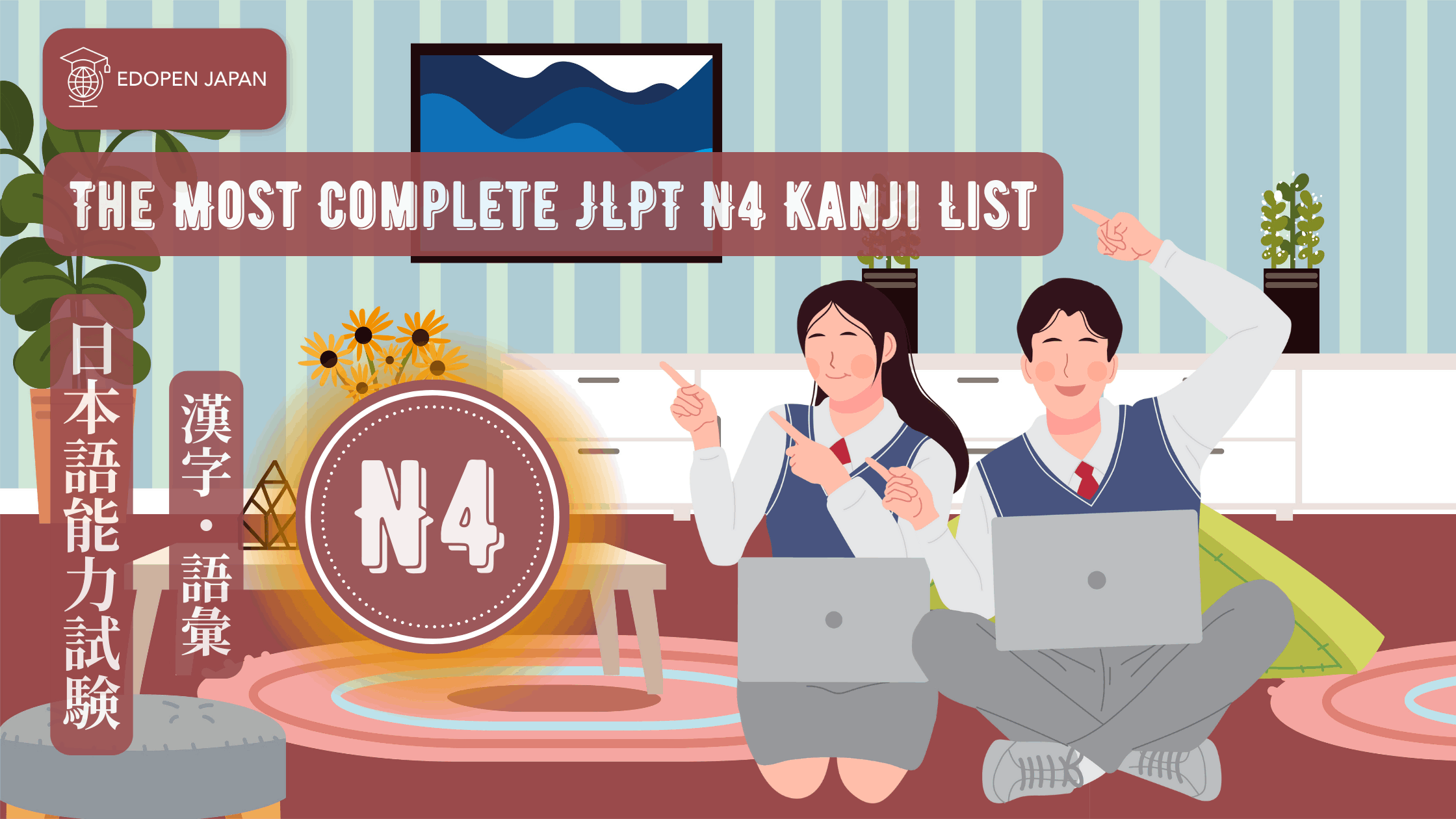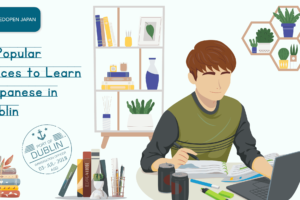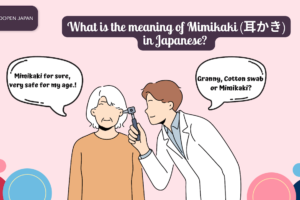How is your study of N4 going so far? What do you find the most challenging aspect of N4 compared to N5? When preparing for the N4 exam, it is important to not only focus on N4 kanji, vocabulary, and grammar but also ensure that your knowledge of N5 is current. Basic concepts can be forgotten while you pursue greater achievements.
In our previous article, we provided a concise introduction to all levels of the JLPT (Japanese Language Proficiency Test) and the testing details for 2023. For more general information about the JLPT, please refer to the article below!
Read also:
The Ultimate JLPT Guides & List of 100 Kanji for JLPT N5
700+ JLPT N5 Vocabulary | The Most Complete Lists
Before moving on to N4, make sure to recognize all 100 kanji necessary for N5 by referring to the provided list that accompanies the JLPT information.
Contents
How to Apply for JLPT N4?
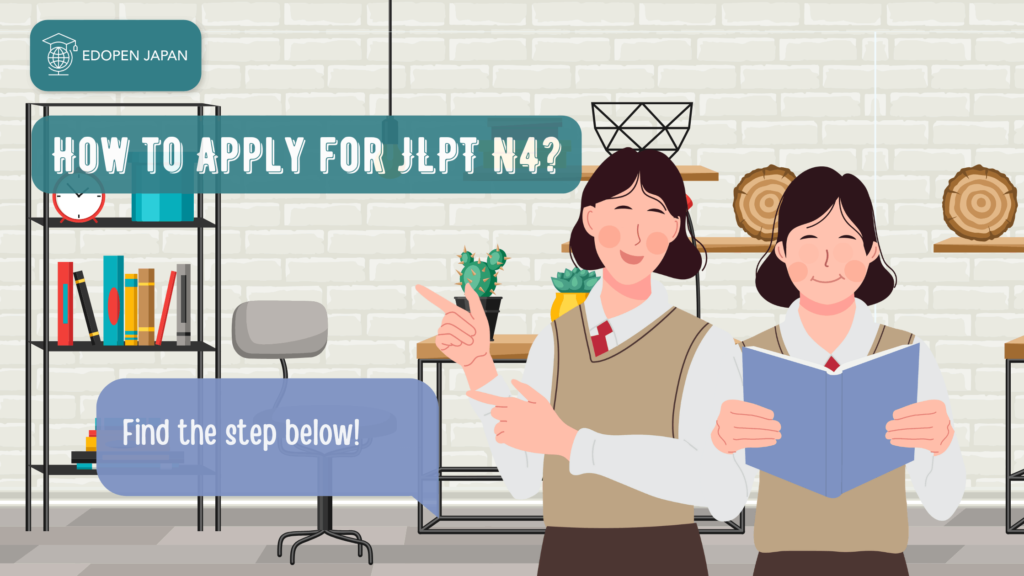
The JLPT is usually held twice a year, in early July and December. More precisely, the JLPT is usually held on the first Sunday of July and December.
1. Taking the JLPT Test in Japan
◉ Release dates of test information: (First test) around early February and (Second test) around early July.
◉ Registration period (online only): (First test) from late March to mid-April and (Second test) from late August to mid-September.
◉ Receipt of paper test voucher: (First test) mid-June and (Second test) mid-November.
◉ Publication of test results: (First test) in early September and (Second test) in early February.
◉ Exam Fee: 6,500 JPY (including excise tax)
| All Levels | Test Date | Registration | Test Voucher | Test Results |
|---|---|---|---|---|
| First test | Sunday, Jul. 3 | Mar. 25 ~ Apr. 15 at 5 PM JST | Jun. 17, 2022 | the end of August 2022 |
| Second test | Sunday, Dec. 4 | Aug. 25 ~ Sep.15 at 5 PM JST | Nov. 18, 2022 | the end of January 2023 |
The application is exclusively online, so please make sure to register and sign in at MyJLPT on the JEES website below!
2. Taking the JLPT Test in the United States
◉ Test Fee: 100 USD.
◉ JLPT in the United States is administered by the American Association of Teachers of Japanese (AATJ). There is no July test in the United States.
◉ You can find the current registration information here: https://www.aatj.org/jlpt.
| N4 | Test Date | Registration | Test Results |
|---|---|---|---|
| First test | – | – | – |
| Second test | Dec. 4 | From August 17 at 9:00 AM until September 13, at 5:00 PM Pacific time | around March 2023 |
3. Taking in other countries or areas
◉ Some countries/cities only held one exam (July or December) each year.
◉ Depending on the country, there are different application deadlines and the date of the result.
◉ Please check the following page for the region where you want to take JLPT: https://www.jlpt.jp/e/application/overseas_list.html.
💡 Due to the spread of the novel coronavirus disease (COVID-19), please visit the JLPT’s official website for the latest updates.
How to Prepare for the JLPT N4 Test?
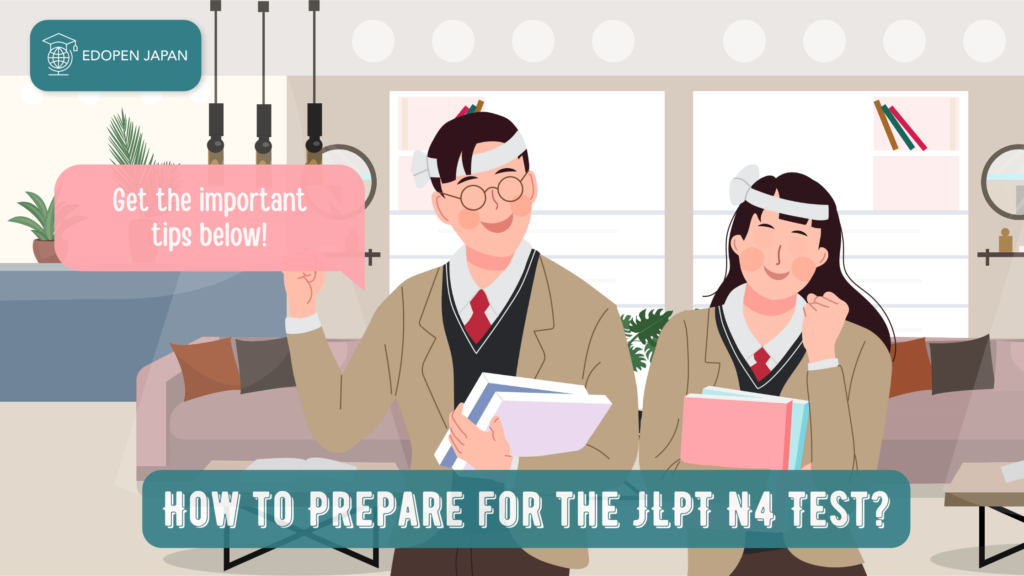
After introducing the JLPT, let’s examine the types of questions featured on the JLPT N4 exam and recommendations for each section.
◉ Linguistic competence required: The ability to understand basic Japanese.
◉ Overall pass marks/full marks: 90/180 points
◉ All questions are multiple-choice questions. No essay question.
In all the levels, the main test sections include:
◉ Language Knowledge(Vocabulary / Grammar): 言語知識(文字・語彙 / 文法)
◉ Reading: 読解
◉ Listening: 聴解
| N4 Test sections | Language Knowledge (Vocabulary / Grammar)・Reading | Listening |
|---|---|---|
| Test time | ① Language Knowledge (Vocabulary): 25 min ② Language Knowledge (Grammar)・Reading: 55 min | ③ 35 min |
| Sectional pass mark / full mark | 38 / 120 points | 19 / 60 points |
Section 1: Language Knowledge (Vocabulary):
| ✎ Kanji reading | Select the correct hiragana for the kanji word given in the question. |
| ✎ Orthography | Select the correct kanji for the hiragana given in the question. |
| ✎ Contextually-defined expressions | Select the most proper word to complete the given sentence in the question. |
| ✎ Paraphrases | Select the option that possesses the closest meaning to the given sentence in the question. |
| ✎ Usages | Select the correct usage(sentence) of the given word in the question. |
Just like in the N5 level, it is necessary to be acquainted with hiragana, katakana, and basic kanji. The vocabulary section will ask you to choose the correct hiragana for katakana or kanji words or vice versa. This section may seem easier compared to others, but neglecting it might result in point deductions.
Section 2: Language Knowledge (Grammar)・Reading
| Language Knowledge (Grammar) | |
| ✎ Sentential grammar 1 (Selecting grammar form) | Select the correct form (tense) of the word that can fit into the question. |
| ✎ Sentential grammar 2 (Sentence composition) | There are 4 consecutive spaces in a sentence. You must construct the sentence with the 4 given options and choose the correct option for the given space. |
| ✎ Text grammar | Select the correct word/particle that can best fit into the blank in an article. |
| Reading | |
| ✎ Comprehension (Short passages) | Choose the correct option to the question according to the given passages. |
| ✎ Comprehension (Mid-size passages) | Choose the correct option to the question according to the given passages (mid-size). |
| ✎ Information retrieval | You might be given graphs, tables, or any data in other forms, which you need to find the answer to the questions |
After studying N4-level grammar, practice creating sentences on your own to confirm correct usage and reinforce your understanding. This approach also helps you to remember the grammar of your own sentences.
As you progress through the exercise book, monitor the time you spend reading to ensure optimal speed for the exam. If necessary, enhance your reading speed prior to the exam.
Section 3: Listening
| ✎ Task-based comprehension | The pictures are included in your exam paper. First the question is played, then a statement follows and the question is played again. |
| ✎ Comprehension of key points | The options are printed on your exam sheet. First, the question is played. Before the statement/talk is played, there’s a short pause to read the option. Finally, the question is played again. |
| ✎ Verbal expressions | The pictures are given in your exam paper, and one person is indicated with an arrow. You’ve to choose the best option that the person could say according to the picture. The options are played only once. |
| ✎ Quick response | There is no question or options printed on the test paper. You will listen to a statement and the options. Choose from the option that can be the best reply to the statement. |
100 Kanji list of JLPT N4
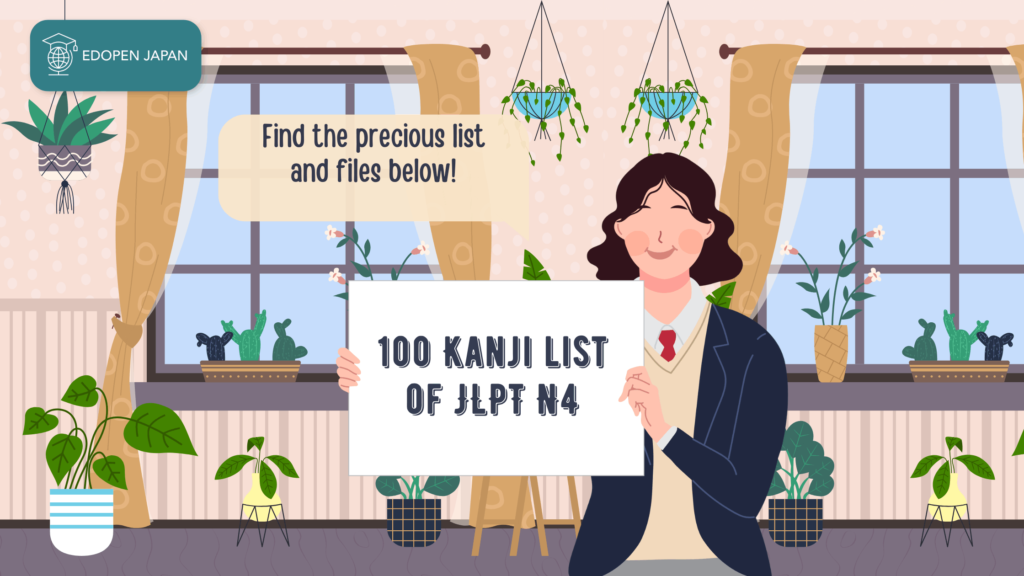
| Kanji 漢字 | Onyomi 音読み | kunyomi 訓読み | word 語彙 | Rōmaji ローマ字 | English |
|---|---|---|---|---|---|
| 爪 | ー | つめ/つま | 爪切り | つめきり | nail clipper |
| 匂 | ー | にお | 匂い | におい | scent, odor, smell |
| 泥 | ー | どろ | 泥棒 | どろぼう | thief |
| 医 | イ | ー | 医学 | いがく | medical |
| 飲 | イン | の | 飲食 | いんしょく | eat and drink |
| 運 | ウン | はこ | 運動 | うんどう | exercise |
| 遠 | エン/オン | とお | 遠慮 | えんりょ | being reserved |
| 汚 | オ | よご/きたな | 汚れる | よごれる | to be stained, get dirty |
| 屋 | オク | や | 屋上 | おくじょう | roof |
| 音 | オン/イン | おと/ね | 音楽 | おんがく | music |
| 階 | カイ | ー | 階段 | かいだん | stairs |
| 街 | ガイ/カイ | まち | 街道 | かいどう | road |
| 割 | カツ | わ/わり/さ | 割れる | われる | to break |
| 慣 | カン | な | 慣れる | なれる | to be used to |
| 間 | カン/ケン | あいだ/ま | 間に合う | まにあう | to be in time, meet a deadline |
| 祈 | キ | いの | 祈る | いのる | to pray, wish, hope |
| 喜 | キ | よろこ | 喜ぶ | よろこぶ | to be happy |
| 議 | ギ | ー | 会議室 | かいぎしつ | meeting room |
| 急 | キュウ | いそ | 急ぐ | いそぐ | to rush, hurry |
| 京 | キョウ/ケイ | ー | 京都 | きょうと | Kyoto |
| 苦 | ク | くる/にが | 苦い | にがい | bitter |
| 迎 | ゲイ | むか | 迎える | むかえる | to welcome, greet |
| 欠 | ケツ | か | 欠ける | かける | lack |
| 港 | コウ | みなと | 空港 | くうこう | airport |
| 向 | コウ | む | 向かう | むかう | to face |
| 財 | ザイ/さい | ー | 財布 | さいふ | purse |
| 雑 | ザツ/ゾウ | ー | 複雑 | ふくざつ | complex |
| 残 | ザン | のこ | 残る | のこる | remain |
| 伺 | シ | うかが | 伺う | うかがう | inquire, ask |
| 止 | シ | と | 止める | とめる | to stop |
| 指 | シ | ゆび/さ | 指輪 | ゆびわ | ring |
| 治 | ジ/チ | おさ/なお | 治る | なおる | to recover |
| 失 | シツ | うしな | 1. 失礼 2. 失敗 | 1. しつれい 2. しっぱい | 1. discourtesy 2. failure |
| 写 | シャ | うつ | 1. 写真 2. 写す | 1. しゃしん 2. うつす | 1. photo 2. copy |
| 拾 | シュウ/ジュウ | ひろ | 拾う | ひろう | to pick up |
| 祝 | シュク/シュウ | いわ | 祝う | いわう | to celebrate |
| 準 | ジュン | ー | 準備 | じゅんび | to prepare, preparation |
| 所 | ショ | ところ | 1. 住所 2. 台所 | 1. じゅうしょ 2. だいどころ | 1. address 2. kitchen |
| 笑 | ショウ | わら/え | 笑う | わらう | to laugh |
| 将 | ショウ | ー | 将来 | しょうらい | future |
| 乗 | ジョウ | の | 乗り換える | のりかえる | to transfer |
| 飾 | ショク | かざ | 飾る | かざる | to decorate |
| 触 | ショク | ふ/さわ | 触る | さわる | to touch |
| 焼 | ショク | や | 焼く | やく | to bake, roast, grill, burn, fire |
| 進 | シン | すす | 進む | すすむ | to go on, proceed, move on |
| 数 | スウ/ス | かず/かぞ | 数学 | すうがく | math |
| 貰 | セイ | もら/か/ゆる | 貰う | もらう | to receive |
| 政 | セイ | ー | 政治 | せいじ | politics |
| 説 | セツ/ゼイ | と | 説明 | せつめい | to explain, explanation |
| 選 | セン | えら | 選ぶ | えらぶ | choose |
| 送 | ソウ | おく | 送る | おくる | to send |
| 増 | ゾウ | ま/ふ | 増える | ふえる | to increase |
| 相 | ソウ/ショウ | あい | 相談 | そうだん | to counsel,counsellation |
| 贈 | ゾウ/ソウ | おく | 贈り物 | おくりもの | gift, present |
| 側 | ソク | がわ | 内側 | うちがわ | inner part, inside |
| 続 | ゾク | つづ | 続く | つづく | to continue, go on, last |
| 卒 | ソツ | ー | 卒業式 | そつぎょうしき | graduation ceremony |
| 遅 | チ | おく/おそ | 遅れる | おくれる | being late |
| 値 | チ | ね/あたい | 値段 | ねだん | price |
| 調 | チョウ | しら/ととの | 調べる | しらべる | to research, search, check |
| 釣 | チョウ | つ | 釣る | つる | to fish, hook, hang |
| 珍 | チン | めずら | 珍しい | めずらしい | uncommon, rare, unusual |
| 通 | ツウ/ツ | とお/かよ | 通行 | つうこう | passing |
| 適 | テキ | ー | 適当 | てきとう | adequately |
| 添 | テン | そ | 添付 | てんぷ | to attach |
| 伝 | デン | つた | 伝う | つた | to convey |
| 途 | ト | ー | 途中 | とちゅう | on the way of |
| 怒 | ド | いか/おこ | 怒る | おこる | get mad, angry |
| 逃 | トウ | に/のが | 逃げる | にげる | to get away, escape, run away |
| 動 | ドウ | うご | 動く | うごく | to move |
| 登 | トウ/ト | のぼ | 登録 | とうろく | registrate |
| 道 | ドウ/トウ | みち | 横断歩道 | おうだんほどう | pedestrian crossing |
| 特 | トク | ー | 特別 | とくべつ | specially, especially, particularly |
| 泊 | ハク | と | 泊まる | とまる | to stay at |
| 番 | バン | ー | 番号 | ばんごう | number |
| 反 | ハン/ホン | そ | 反対 | はんたい | opposite(direction), opponent |
| 負 | フ | ま/お | 負ける | まける | to lose |
| 沸 | フツ | わ | 沸かす | わかす | to boil |
| 払 | フツ | はら | 払う | はらう | to pay |
| 物 | ブツ/モツ | もの | 物理 | ぶつり | physics |
| 辺 | ヘン | あた | 周辺 | しゅうへん | surround |
| 返 | ヘン | かえ | 返事 | へんじ | response, answer, reply |
| 便 | ベン/ビン | たよ | 便利 | べんり | convenient/useful/helpful |
| 包 | ホウ | つつ | 包む | つつむ | to wrap up |
| 忘 | ボウ | わす | 忘れ物 | わすれもの | things being forgoten |
| 房 | ボウ | ふさ | 冷房 | れいぼう | air-conditioning |
| 貿 | ボウ | ー | 貿易 | ぼうえき | trade |
| 眠 | ミン | ねむ | 眠い | ねむい | feel sleepy |
| 鳴 | メイ | な | 鳴る | なる | to sound |
| 約 | ヤク | ー | 予約 | よやく | to make an appointment |
| 輸 | ユ | ー | 輸出 | ゆしゅつ | to export |
| 郵 | ユウ | ー | 郵便局 | ゆうびんきょく | post office |
| 優 | ユウ | やさ | 優しい | やさしい | kind, soft, gentle, |
| 用 | ヨウ | もち | 用事 | ようじ | things to do, matter |
| 頼 | ライ | たの/たよ | 頼む | たのむ | rely, trust, order, request |
| 落 | ラク | お | 落とす | おとす | drop, lower |
| 旅 | リョ | たび | 旅館 | りょかん | hotel |
| 料 | リョウ | ー | 料理 | りょうり | to cook, dish, cuisine |
| 戻 | レイ | もど | 戻る | もどる | to return, go back |
| 歴 | レキ | ー | 歴史 | れきし | history |
| Kanji 漢字 | Onyomi 音読み | Kunyomi 訓読み | Word 語彙 | Rōmaji ローマ字 | English |
Quick Link
| 1. JLPT Official Site | https://www.jlpt.jp/e/index.html |
| 2. JLPT-Sample Questions | https://www.jlpt.jp/e/samples/forlearners.html |
| 3. JLPT-Composition of Test Sections and Items | https://www.jlpt.jp/e/guideline/testsections.html |
| 4. JEES website (For application) | https://info.jees-jlpt.jp/ |
| 5. American Association of Teachers of Japanese (全米日本語教育学会) | https://www.aatj.org/jlpt-us |
Summary
We hope you were able to locate the resources you needed for the JLPT N4. Attached below are the PDF and Excel files for downloading the 100 kanji list for the JLPT N4.

